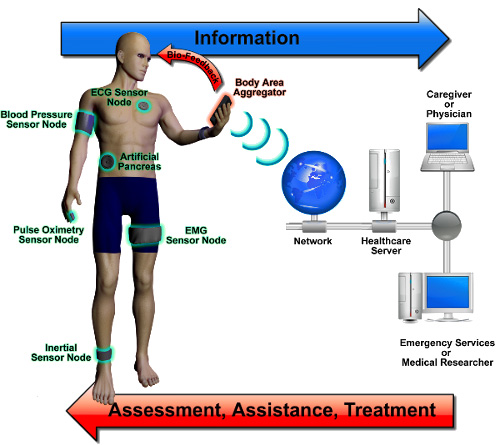The University of Virginia and three other universities will partner on a national nanotechnology research effort to create self-powered devices to help people monitor their health and better understand how their environment affects it, the National Science Foundation announced today.
The NSF Nanosystems Engineering Research Center for Advanced Self-Powered Systems of Integrated Sensors and Technologies, or ASSIST, to be headquartered on North Carolina State University’s Centennial Campus, includes the four partner schools – U.Va., North Carolina State, Pennsylvania State University and Florida International University – plus five other affiliated universities and about 30 industry partners in its global research consortium. ASSIST will be funded by an initial five-year, $18.5 million NSF grant.
“U.Va. is proud to team up with our partner institutions and industry leaders through this exemplary international network,” said Thomas C. Skalak, U.Va.’s vice president for research. “The world’s most pressing challenges will be solved through collaborative partnerships like these, and U.Va. is pleased to be contributing to this model of real value creation.”
ASSIST researchers will use the tiniest of materials – nanomaterials and nanostructures – to develop self-powered health monitoring sensors and devices that use body heat and motion as power sources. These devices could be worn on the chest like a patch, on the wrist like a watch, as a cap that fits over a tooth, or in other ways, depending on the biological system that is being monitored.
“We are pleased to be a part of this important center,” said James H. Aylor, dean of U.Va.'s School of Engineering and Applied Science. “The work we are doing at U.Va. on ultra-low-power circuits and wearable technology for wireless health are a great fit for the center's mission, so we are excited about the advances that will come from this collaboration.”
New devices created from this partnership could transform health care by improving the way doctors, patients and researchers gather and interpret health data. Armed with uninterrupted streams of heart rate readings, respiration rates and other health indicators, as well as personalized exposure data for environmental pollutants, sick people could better manage chronic diseases, the elderly could be monitored by health care professionals from a distance and healthy people could make better decisions to keep themselves fit.
“Our work at U.Va. relies on extensive interaction with real doctors and patients to inform our optimization of wearable body sensors to meet medical needs in the most efficient way possible,” said U.Va. electrical and computer engineer John Lach, who will oversee the incorporation of medical requirements into the ASSIST systems.
As an example of environmental monitoring related to health, personalized exposure data for pollutants such as ozone and carbon monoxide could help a child suffering from asthma avoid an environmental trigger for an attack. Miniaturized devices the size of a pen or wristwatch will make compliance simpler and therefore more likely, resulting in better health outcomes and reduced health costs to society.
“Wearable sensors that are small enough to be worn unobtrusively have extremely limited space to store energy," said U.Va. electrical and computer engineer Ben Calhoun, who leads the ASSIST research thrust on integrated sensor node design. "By harvesting energy from the body, we can eliminate the battery from the system, but the circuits need to use extremely low amounts of energy.”
Calhoun’s group previously demonstrated a completely battery-less wearable electrocardiogram sensor that collects data, analyzes it for cardiac arrhythmias and radios the results to the user.
North Carolina State researchers will develop thermoelectric materials that harvest body heat and new nanosensors that gather additional health information from the body such as heart rates, oxygen levels and respiration data. In addition, the researchers will find ways to package the technology developed by the center into wearable devices.
The center’s partner institutions will play several important research roles. Penn State researchers will create new materials and devices and help understand the correlations between environmental exposure and human health. The group from Florida International University will create sensors that gather biochemical signals from the body, such as stress levels.
The results of that work, coupled with low-power radios developed by the University of Michigan, will be used to process and transmit health data gathered by the sensors to computers and consumer devices, such as cell phones, so patients, doctors and researchers can easily digest it. The University of North Carolina at Chapel Hill will provide ASSIST with medical guidance and arrange testing of the center’s technology.
“We have assembled a comprehensive team that works together closely under a systems-driven approach to tackle this challenging set of global health problems,” said Veena Misra, the center's director and a professor of electrical and computer engineering at North Carolina State.
ASSIST also has foreign partnerships with the University of Adelaide, the Korea Advanced Institute of Science and Technology, and the Tokyo Institute of Technology.
ASSIST will draw on the expertise of industry partners to help guide the center’s work to the marketplace. These partners include companies and agencies involved in nanomaterials and nanodevices, integrated chip manufacturing, software development, bioengineering and health care.
The center will feature a nanotechnology education program, including an undergraduate concentration and a graduate master’s certificate, as well as a personalized professional-development program for graduate students.
The center also will partner with 11 middle and high schools in Virginia, North Carolina, Florida and Pennsylvania to develop outreach activities that bring nanosystems engineering into K-12 classrooms. Students in partner high schools will be given the opportunity to participate in ASSIST research.
The five-year NSF grant for ASSIST is renewable for an additional five years and was awarded following a two-year selection process. The grant is among a new group of Engineering Research Center awards that invest in nanotechnology.
Media Contact
Article Information
September 4, 2012
/content/uva-nsf-partner-nanosystems-engineering-research-center-self-powered-health-monitoring

